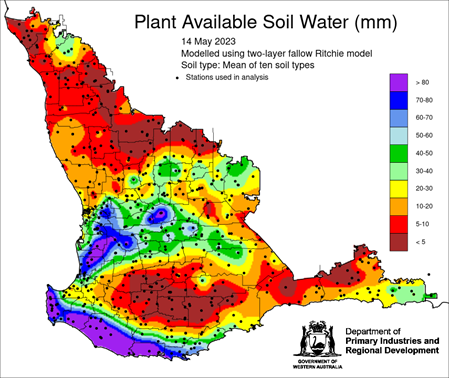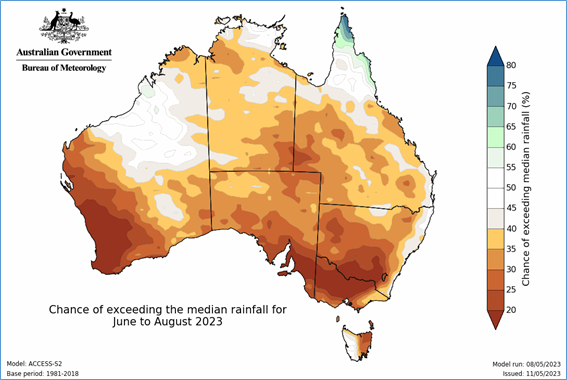The 2023 Grain Season – Excellent start for some, very dry for others
The 2023 grain growing season is shaping up to be one of extremes already. For the calendar year so far, a big swath of country in the centre of the state has received enough rain to bog machinery while there are other growers who have received very little rain. The predicted low decile year is certainly shaping up for some regions whilst others could be forgiven for thinking they are on a different planet.
Climate models are convinced it is going to be a drier than average winter, with sea temperatures and position of blocking high pressure systems seeming to indicate this is likely to be the case. Whilst it is early days, and accuracy of predictions in the past have been low for this time of year, growers in regions of the state where there has been lower falls of rain are adjusting planned sown areas back significantly from 2022.
Seeding will wind up for most growers by the end of next week. Historically this will be an early finish and is a reflection of the early rains in March that got everyone going, and the reduction in area sown in the dry areas. The hesitancy to not over-commit on the back of a couple of good years, has been reflected in the reduction in area of lupins, beans and chickpeas, and the higher risk crops such as canola being substituted to wheat or left out to pasture or fallow. As a result, the cropped area is likely to be back around the 8.2 to 8.3 million hectare mark for the state, a drop off from 2022 of about 8 per cent in area. This could increase slightly if more rain falls over the next few weeks.
Canola area is down around 18 per cent on 2022, which is more a reflection of the timing and amount of rainfall across the zones rather than the reduction in price from 2022. Wheat area will be back slightly from 2022 due to the ongoing dry conditions in the north of the state, and the low rainfall fringes further south opting for an increase in fallow from 2022. Barley area will be back slightly from the substitution to wheat which has continued on in a once barley dominated region of the state. Lupins will be down as well, mostly reflected by reduced plantings in the Geraldton Port Zone. The kick in oat plantings from slightly higher prices offered during seeding did not eventuate and area planted will be the same or slightly down on 2022. Fringe pulse crops are also down in area due to current low prices.
Potential grain production for 2023 will certainly now not match the high of 2022 or 2021. The reduced area planted, the lack of subsoil moisture in the top third of the state’s grain growing region, and the percentage of crop still not out of the ground, will add up to significantly reduced potential tonnage production in 2023.

Seasonal Outlook
Ian Foster, Department of Primary Industries and Regional Development

Climate Summary
Thunderstorms during late March and early April have brought welcome rain for much of the central agricultural area. This has allowed crop establishment and pasture germination, although conditions for the northern cropping area and parts of the South Coast have been patchier.
April rain has been variable to date, with eastern parts of the northern cropping area, parts of the great Southern and western parts of the Esperance area being notably dry. This is shown in estimated root-zone soil water storage (Figure 1). DPIRD soil moisture probes indicate stored water from about 500mm depth at the majority of its locations, presenting an opportunity for crops if roots can access it.
Drier than normal conditions are expected to continue until late May. June rain is also likely to be below normal, so follow-up rain could be patchy, with longer gaps between rain events.
There is ongoing agreement among climate models that below normal rain is more likely from June to August over most of Australia (Figure 2). Atmospheric pressure remains likely to be above normal south of Australia, which is associated with lower rainfall over southern WA.
Climate models continue to predict an El Niño event in the Pacific Ocean, and a positive Indian Ocean Dipole event in the Indian Ocean from June or July onwards. The combined impact from these events is to suppress rainfall over much of Australia in winter and spring.
Temperatures at the surface and at depth in the Pacific Ocean have primed the ocean basin for an El Niño event, although at this stage the tropical atmosphere has not fully adjusted to this.
Additional information is available from:
BoM: Decile rainfall for January to April 2023
BoM: Rainfall outlook for the next week
BoM: Seasonal Rainfall Outlook

Figure 1. Estimated plant available soil water storage at 14 May 2023. From DPIRD.

Figure 2. Chances of exceeding median rain for June to August 2023, based on model run 8 May 2023. From Bureau of Meteorology.
Geraldton Zone
The light showers last weekend helped to bring up dry sown crops although most have no or very little subsoil moisture and will need another rain within a few weeks to survive. Crops that went in following the 60 to 100mm of rain along the eastern edges of the zone in March, are now 3 to 4 leaf for wheat and 6 leaf for canola. The coastal areas have very little crop emerged and the north Midlands is the same. Crop out of the ground ranges from two thirds for some, down to nothing for others. In the last two weeks, growers have been hesitant to go full steam ahead due to the dry outlook.
The reduction in canola area ranges between 20 to 50 per cent and for some growers they have cut canola completely out of their programs. Lupins are similar. There has been a dramatic reduction in canola and lupins with very few lupins sown in the Geraldton Port Zone. It is going to be a mainly cereal dominated program for most in 2023.
Most growers are fortunate following the previous good seasons to be in a financial position of not having to put crop in, and can revert to fallow. Most growers have or will drop a couple of paddocks out of crop now in the region. This reluctance to not give back the gains from the last few years is shared by growers across the state.
Cereals are being bogged in to 50 to 60mm deep at sowing and are emerging well on the small amount of subsoil moisture available. About 50 per cent of the northern region crop is out of ground with large areas around Three Springs down to Carnamah and east to Perenjori being very dry.
Kwinana Zone
Kwinana North Midlands
Growers in the region have an uncomfortable feeling that 2023 is shaping up to be similar to 2019. Like 2019, there has been virtually no summer rain and soil profiles are completely dry from the previous year.
Very little crop had emerged in the region prior to last weekend, where falls of between 5 to 10mm have allowed the canola, lupins and some of the barley that had been sown dry, to emerge. There is still the majority of wheat to be sown which is around 40 to 50 per cent of the cropped area, and a small percentage of barley still to be sown as well.
Growers with sheep in the central and western areas are busily unloading numbers as paddock feed has run out. Ironically, the crop area could sneak up a little on planned hectares due to less need for pasture paddocks, which is the opposite of what would normally be the case in a dry year. The eastern areas are now dropping back programs and increasing the area to fallow.
Kwinana South
Good rains in the first half of April have resulted in a lot of canola in the ground again in 2023, although the area is slightly down on what was planted in 2022, which was historically the largest area planted on record in the region. The area of canola in western areas is similar to the 2022 Season. The canola is looking very good now after the unexpected 5 to 8mm of rain that fell last weekend. 80 per cent of the canola establishment has been excellent with most of the early sown canola at 6 to 8 leaf. Recent light rains have pushed the remainder of crops up that were sown dry.
On average there has been a 20 per cent reduction in plantings in the eastern areas and about the same planted as 2022 in the west.
Following the canola, sowing much of the cereal area went in dry during the 3 to 4 weeks of dry weather at the end of April and the start of May. The recent rain has helped those earlier sown crops to freshen up and the dry sown crops to emerge. The has been a reduction in lupin area to simplify programs, and with little benefit other than the nitrogen contribution, the reduction in urea and liquid nitrogen price has sealed its’ fate for 2023.
Most growers are 70 to 80 per cent through seeding and have had a good run with timing of rain, and some will be finished by 25th May.
Growers are considering their nitrogen strategies on their early sown canola paddocks. The dry forecast, soil type and subsoil moisture are the main considerations on how much to tailor application rates. There is very good grain yield potential with these early sown crops and even with lower prices the potential for profit with canola is likely to exceed other crop types.
The 100mm of rain at the end of March and early April resulted in weeds growing at the rate of knots and growers struggled to get across all their paddocks. As a result, 20 to 30 per cent of paddocks were sprayed out later than most would have liked. This dried out the surface profile and resulted in those paddocks being sown dry rather than into moisture.
Sheep feed is tight at present, and with pasture sowing deferred due to the opportunity with sowing canola, the shortage of sheep feed is unlikely to improve until spring.
Kwinana North East
The zone is mostly having a repeat of the start to the 2022 season with good falls of rain in March and April to bring subsoil moisture reserves up and giving growers an early seeding opportunity. Continued light falls of rain have kept the wheels turning and most will wind up seeding in a week or so. The rain has tailed off in the further reaches of the zone, in the north and east, although it is a much narrower strip than in the 2022 and 2021 seasons. These areas will end up with less crop sown than planned with significant percentages going to fallow.
The increase in canola area in 2022 has carried through to 2023, although the final area will probably be less as the eastern and north-eastern fringes of the zone have not had the rain to date that they did in 2022.
Growers in the wetter areas of the zone are still sowing into moisture and will finish with most of the cereals sown being able to germinate.
Albany Zone
Albany West
The northern areas of the zone around Williams down to Darken have had good rainfall over the last couple of months, with crops up and growing nicely. In contrast, the southern areas around Kojonup, Rocky Gully and down to Mount Barker have not been as lucky with the rain and it is now getting quite dry with emerged canola crops starting to wilt. There are pockets that are very dry, including a small area around Tambellup where crops are not out of the ground.
The definition of “dry” is different in the high rainfall southern regions and crops have been emerging when growers have chased moisture further down in the profile, something they would have considered to be too dry to do only a few years ago.
The planned crop type mixture for the region, has stayed as planned, with about the same area of canola planted as in 2022. Canola crops sown following the rain at the end of March and early April are ready for a nitrogen top-up and their first weed control application. Crops were slow to get to 4 leaf and with the dry forecast coming up, this has probably been a good thing.
Growers are carrying more sheep than normal as is the case in the rest of the state, and whilst pastures were looking good up until recently, the cooler nights and lack of rain has put the brakes on growth in the last week or so.
Albany South
Rainfall in the region has been variable, with the coastal areas and the corner strips around Gardner to the east and Mount Barker to the west faring better than to the north. There is a very dry stretch of country from Gnowangerup diagonally southeast to Jerramungup where little of the canola sown has emerged. Most of the canola sown in the remainder of the region is up and growers are moving onto the cereals.
Lupin and faba bean areas are down and the heavier country in the area of fallow in the lower rainfall regions will be up from 2022. Pastures are under pressure from the increase in sheep numbers being held on farm and many growers are wondering whether once they have unloaded numbers, if they will continue with sheep in the future. It is likely this year will see a fundamental adjustment downwards of the states sheep flock with many growers convinced that the days of sheep on their properties are numbered.
Mice have caused a bit of havoc on barley stubbles, preferring to continue feeding on crop residues rather than take baits.
Albany East (Lakes Region)
Growers in the region will mostly be finished seeding by next week. A bit less than half of the sown area is up, mostly on the lighter soils and those paddocks that went in earlier in the program. The rainfall has been patchy with okay moisture in some parts of farms and dusty dry in others. There has not been enough rain on the heavier soils to have germinated crops. The region did not receive the rain over harvest, as they did further south, and the profiles are now quite dry.
Pasture paddocks were left longer than normal before knocking down for those growers that run sheep, as most were carrying more numbers than usual for this time of the year, and were hoping for an improvement in selling opportunities. This has resulted in drying out the soil profile and the lack of follow up rains has forced growers to dry sow or leave paddocks out for now. This will result in a slight decrease in cropped area for the region.
Canola area is similar to or just below the area sown in 2022, as the timing of the early rains gave growers the confidence to sow. The impact on area sown has been determined more by the timing of rain and amount rather than the decrease in canola price from 2022. Growers are now confident that the new hybrid varieties can make up the yield to return a profit even at these lower prices.
Lupin area dropped off in 2022 and plantings this year have been similar. The kick in oat prices during the early stages of planting enticed some grower to sow an extra paddock of two, although the total increase in area for the region will be small.
Esperance Zone
Plans for the year are pretty on track so far. Much of the planned canola area has been planted and has ended up being a similar area to 2022. Barley area is down from 2022 and wheat is up, except for a slight reduction in area in the lower rainfall western areas where rainfall has been light up until now. Lupin and pulse crops are still out of favour.
Growers are 70 to 80 per cent through sowing with about 50 per cent of the crop up. There has been more dry sowing in the region than other areas of the state as the annoying rain over harvest has and will provide a beneficial buffer of subsoil moisture if the season ends up dry as predicted.
It has been the opposite of last year, where this year growers in the west are struggling for moisture and most have been sowing dry for their full programs. The eastern portion of the zone around Beaumont, east of the Gums and Grass Patch is in much better shape than west of Scaddan and Cascades. The coastal areas have had enough rain to get crops up and away.
There have been a couple of wind events in the early canola paddocks and mice have caused problems in the east in barley stubbles where hail or delayed harvest from 2022 has provided a feed source.